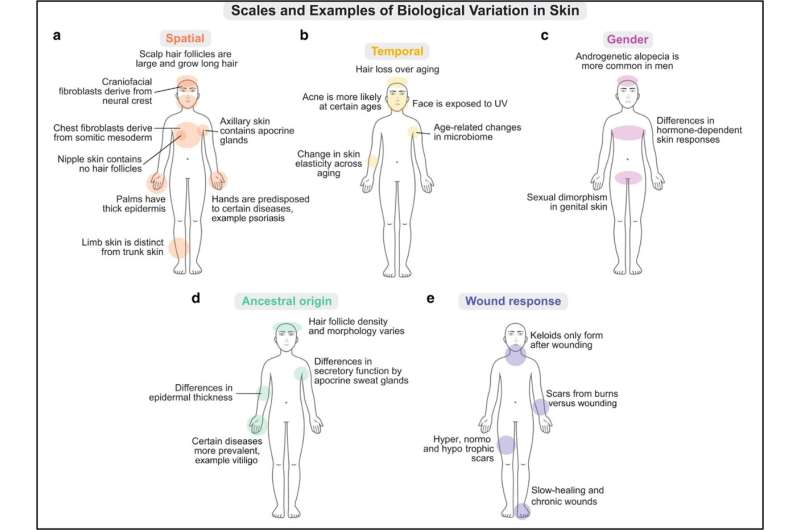This article has been reviewed according to Science X's editorial process and policies. Editors have highlighted the following attributes while ensuring the content's credibility:
fact-checked
peer-reviewed publication
proofread
Dermatology experts say the time is right to develop a consensus Human Skin Cell Atlas

As a single organ, our skin is able to perform a broad repertoire of vital functions. Dermatology experts call for a reference guide to single-cell composition of normal human skin, which is still lacking. A grassroots movement to establish a "Human Skin Cell Atlas" is taking shape, as reported in a review in the Journal of Investigative Dermatology.
A global team of experts has outlined a roadmap as a first step towards creating a comprehensive and inclusive reference work on this important topic.
Our skin performs vital functions, such as protecting us from external threats (pathogens, UV rays), regulating our body's temperature, giving us our sense of touch, and enabling us to express ourselves via cranial and facial hair. Skin is also anatomically diverse across the body, a feature biologists call "regional specificity."
For instance, hairless skin on our palms with complex fingerprints is dramatically distinct from skin with hair on our scalp. To perform its numerous functions and to maintain prominent regional specificity, skin consists of several distinct cell types, which in turn, each contain numerous cell states.
Using single-cell RNA-sequencing (scRNA-seq) technology, researchers can study gene expression signatures of many individual cells in tissues and then bioinformatically evaluate how they work together to perform tissue functions.
Co-lead author Maksim Plikus, Ph.D., from the Department of Developmental and Cell Biology at the University of California, Irvine, explains, "Many co-authors on this review were early adopters of single-cell technologies. This technology requires in-depth understanding of bioinformatic approaches and detailed knowledge of conserved gene expression features of distinct skin cell types. As such, the research field has now reached a critical inflection point when a reference guide to single-cell composition of normal human skin is acutely needed."
Responding to this critical need, the Human Cell Atlas is an international grassroots effort to generate a comprehensive single-cell reference of every human organ.
Co-lead author Maria Kasper, Ph.D., from the Department of Cell and Molecular Biology at the Karolinska Institute, adds, "Because we are passionate about human skin biology and versed in single-cell methods, we put together this review as a guide for achieving the goal to generate the Human Skin Cell Atlas (HSCA). This review, a roadmap of a kind, will be the first step, followed by a joint effort to generate the actual atlas."
The initial atlas will be based on sequenced cells collected from healthy human skin. The authors envision that this atlas would then be used as the basis to uncover both conserved and varying human skin cell populations as well as molecular differences that arise upon skin diseases.
Once complete and up and running as an open-source online resource, it will be possible to utilize a consensus atlas for semi-automated mapping of patient-specific changes in any future scRNA-seq data. In addition, in the future, the HSCA reference could be used to support personalized medicine, such as single-cell-based personalized diagnostics of skin diseases.
The review is a collection of knowledge from skin experts ranging from basic scientists to clinicians and from trainees to seasoned principal investigators. It outlines key considerations for the atlas in order to comprehensively represent skin cells across five scales: spatial, temporal, gender, ancestral origin, and wound response scales.
As part of the roadmap to develop the HSCA, the authors also emphasize the importance of global representation, reflecting skin of the broader human population, rather than that of only selected human groups that are typically over-represented in biomedical research.
They further highlight that for the HSCA to be balanced, scientists need to comprehensively consider unintentional biases that can be easily introduced during single-cell data collection and generation. Such biases include under-representation of skin from minority groups, difficult-to-sample body sites, and technical consistency in generating scRNA-seq data among different laboratories.
Finally, a standardized metadata template is proposed to collect detailed information when generating new scRNA-seq datasets.
More information: Maria Kasper et al, A Roadmap for a Consensus Human Skin Cell Atlas and Single-Cell Data Standardization, Journal of Investigative Dermatology (2023). DOI: 10.1016/j.jid.2023.03.1679
Journal information: Journal of Investigative Dermatology
Provided by Elsevier




















